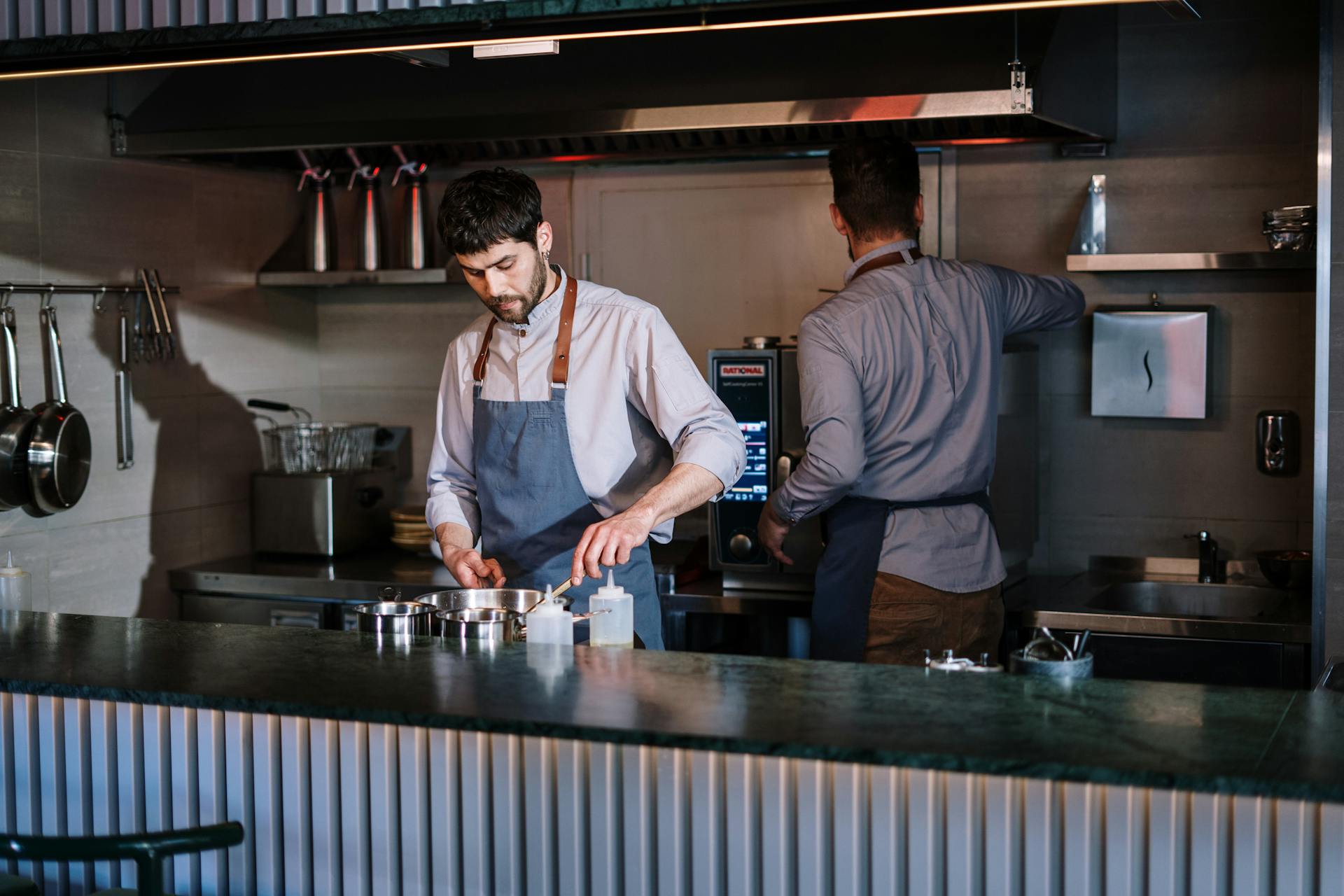Top Flooring Solutions to Reduce Noise in Open Kitchen Restaurants: A Comprehensive Guide
When it comes to designing an open kitchen restaurant, one of the most critical aspects to consider is noise reduction. The clatter of dishes, the sizzle of food on the stovetop, and the hum of conversation can all contribute to a noisy environment that may not be ideal for either the kitchen staff or the dining patrons. In this guide, we will explore the top flooring solutions that can help mitigate noise in open kitchen restaurants, ensuring a more comfortable and efficient workspace.
Understanding the Importance of Noise Reduction in Restaurants
Noise reduction is not just about creating a more pleasant dining experience; it also plays a significant role in the well-being and productivity of the kitchen staff. High noise levels can lead to fatigue, stress, and even hearing damage over time. Here’s what Emily Henderson, a design expert, has to say about the importance of sound dampening:
In the same genre : Top Proven Strategies to Safeguard Your Busy City Bar Against Theft
“Your best soundproofing will come from a felt or acoustic foam floor underlayment – so keep that in mind, future renovators – but a thick rug pad can help dampen sound, too.”
In a restaurant setting, this is particularly crucial as it can impact the overall ambiance and the ability of staff to communicate effectively.
Also to read : Top Essential Tools You Need to Launch a Thriving Catering Business
Best Flooring Options for Noise Reduction
Ceramic and Porcelain Tile
While ceramic and porcelain tiles are popular for their durability and water resistance, they are not the best options for noise reduction. Here are some pros and cons to consider:
Pros:
- Durability: They resist wear and scratches, making them great for busy kitchens.
- Water Resistance: They don’t absorb water, so they’re perfect for spills.
- Versatility: Available in many styles, colors, and textures, including ones that look like wood or stone.
- Low Maintenance: Easy to clean and don’t need sealing if they are glazed.
Cons:
- Cold and Hard: Tiles can be uncomfortable to stand on for long periods and can be slippery when wet.
- Installation: Installing tiles can be hard work and usually requires a professional.
Despite their many advantages, ceramic and porcelain tiles are not ideal for sound absorption.
Luxury Vinyl Flooring (LVP/LVT)
Luxury vinyl flooring is a more promising option for noise reduction due to its softer and more flexible nature.
Pros:
- Waterproof: Excellent for kitchens due to its water resistance.
- Comfort: Softer to stand on than ceramic tile, which is nice for long cooking sessions.
- Aesthetic Variety: Can look very realistic, mimicking natural materials like wood and stone.
- Easy Installation: Many types are easy to install yourself with peel-and-stick or click-lock options.
Cons:
- Potential for Fading: Sunlight can cause some vinyl floors to fade over time.
- Less Eco-Friendly: Made from synthetic materials, which aren’t the most sustainable.
Luxury vinyl flooring can help reduce the noise of foot traffic and kitchen activities, making it a viable option for open kitchen restaurants.
Engineered Hardwood
Engineered hardwood offers a balance between aesthetics and functionality, including some sound-absorbing properties.
Pros:
- Aesthetic Appeal: Has the classic beauty of hardwood flooring.
- Stability: Less likely to warp or be affected by humidity than solid wood.
- Refinishing: Some can be refinished, which can extend their life.
- Sound Absorption: Wood generally has better sound-absorbing qualities compared to tile or vinyl.
Cons:
- Water Sensitivity: Can still be damaged by standing water.
- Cost: Can be more expensive than vinyl or tile.
Engineered hardwood is a good choice for reducing noise, especially when combined with acoustic underlayment.
Cork Flooring
Cork flooring is an eco-friendly and highly effective option for noise reduction.
Pros:
- Comfort: Soft underfoot, which helps reduce fatigue when standing for long periods.
- Sound Absorption: Helps reduce noise significantly, making it great for open kitchens.
- Eco-Friendly: Made from renewable resources, making it a sustainable choice.
- Insulation: Feels warm underfoot, unlike tile.
Cons:
- Water Sensitivity: Can swell if it gets too wet, so it’s not waterproof.
- Durability: Can get scratched or dented more easily than tile or vinyl.
Cork flooring is an excellent choice for noise reduction and comfort in high-traffic kitchen areas.
Additional Soundproofing Solutions
Acoustic Underlayment
Using an acoustic underlayment can significantly enhance the sound-absorbing capabilities of your flooring.
- Felt or Acoustic Foam: These materials are dense and better suited to absorb sounds from speech or music. For example, a 1/2″ felt pad or a 7/16″ memory foam pad can make a substantial difference.
Rubber Flooring
Rubber flooring is another option that can help reduce noise, especially in high-traffic areas.
- Sound Absorption: Rubber is naturally sound-absorbing and can reduce the noise of foot traffic and kitchen activities.
- Slip Resistant: Often textured to provide traction, making it safer in wet conditions.
- Easy Clean: Rubber flooring is generally easy to clean and maintain.
Here is a detailed list of the benefits of rubber flooring:
- High Traffic Tolerance: Suitable for busy commercial kitchens.
- Sound Waves Reduction: Effective in reducing the impact of sound waves.
- Comfort: Softer than many other flooring materials, reducing fatigue.
- Eco-Friendly: Many rubber flooring options are made from recycled materials.
Comparative Table of Flooring Options
| Flooring Type | Durability | Water Resistance | Comfort | Sound Absorption | Eco-Friendliness | Cost |
|---|---|---|---|---|---|---|
| Ceramic/Porcelain | High | High | Low | Low | Low | Moderate |
| Luxury Vinyl | High | High | Medium | Medium | Low | Moderate |
| Engineered Hardwood | High | Medium | Medium | Medium | Medium | High |
| Cork | Medium | Low | High | High | High | Moderate |
| Rubber | High | High | High | High | Medium | Moderate |
Practical Insights and Actionable Advice
When choosing the best flooring solution for your open kitchen restaurant, consider the following tips:
Assess Your Needs
- Evaluate the level of foot traffic and the types of activities that will be taking place in the kitchen.
- Consider the aesthetic you want to achieve and how it will align with your restaurant’s design.
Combine Flooring with Other Soundproofing Solutions
- Use acoustic underlayment to enhance the sound-absorbing properties of your flooring.
- Install acoustic panels on walls and ceilings to further reduce noise.
Maintain Your Flooring
- Regularly clean and maintain your flooring to ensure it remains effective in reducing noise.
- For materials like cork and hardwood, ensure they are properly sealed and protected from water damage.
Here’s a quote from a Reddit user who emphasized the importance of maintaining a kitchen environment:
“I did it mostly to cut down noise so I would use the vent fan more often and I can carry on a conversation with somebody at normal conversation levels standing right next to the stove when I’m cooking.”
Choosing the right flooring for an open kitchen restaurant is a critical decision that can significantly impact the overall ambiance and functionality of the space. By understanding the pros and cons of different flooring options and incorporating additional soundproofing solutions, you can create a more comfortable and efficient kitchen environment.
In the words of a flooring expert from Empire Today:
“Empire Today has many flooring types available to homeowners, each with one-year installation warranties. Whether you’re interested in indoor/outdoor carpeting, Berber, or more plus options, you can find something to suit your needs through a consultation with Empire.”
By selecting the best flooring solution and implementing soundproofing measures, you can ensure your open kitchen restaurant is both functional and welcoming for both staff and patrons.






